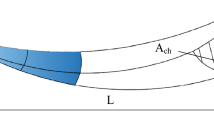Abstract
The prediction of grinding force has great significance in improving grinding quality and efficiency. This paper presents a predictive force model in plunge facing grinding considering both the cutting mechanism of single grain and the random nature of wheel topography. The model includes cutting deformation force and frictional force, which mainly depend on undeformed chip cross-section area and wear flat area of grains. In order to overcome the difficulties for calculating the cross-section area of irregular polyhedral grains, a digital graphic scanning (DGS) method is proposed in this research. Single grain scratch test and hardness test are carried out to obtain the model coefficients. The validation experiments performed on a face grinding machine show a good match of the predictive and measured forces for different grinding parameters.
















Similar content being viewed by others
Data availability
Not applicable.
References
Denkena B, Grove T, Behrens L (2015) Significant influence factors on the grinding tool wear and cutting mechanisms during grinding of PCBN inserts. Prod Eng 9:187–193
Brinksmeier E, Aurich JC, Govekar E, Heinzel C, Hoffmeister HW, Klocke F, Peters J, Rentsch R, Stephenson DJ, Uhlmann E, Weinert K, Wittmann M (2006) Advances in modeling and simulation of grinding processes. CIRP Ann Manuf Technol 55:667–696
Werner G (1978) Influence of work material on grinding forces. CIRP Ann Manuf Technol 27:243–248
Li L, Fu J, Peklenik J (1980) A study of grinding force mathematical model. CIRP Ann Manuf Technol 29(1):245–249
Durgumahanti USP, Singh V, Rao PV (2010) A new model for grinding force prediction and analysis. Int J Mach Tools Manuf 50:231–240
Aslan D, Budak E (2014) Semi-analytical force model for grinding operations. Procedia CIRP 14:7–12
Hecker R, Liang S, Wu X, Xia P, Jin D (2007) Grinding force and power modeling based on chip thickness analysis. Int J Adv Manuf Technol 33:449–459
Chang H, Wang J (2008) A stochastic grinding force model considering random grit distribution. Int J Mach Tools Manuf 48(12):1335–1344
Wang D, Ge P, Bi W, Jiang J (2014) Grain trajectory and grain workpiece contact analyses for modeling of grinding force and energy partition. Int J Adv Manuf Technol 70(9–12):2111–2123
Azizi A, Mohamadyari M (2015) Modeling and analysis of grinding forces based on the single grit scratch. Int J Adv Manuf Technol 78(5–8):1223–1231
Zhang Y, Li C, Ji H, Yang X, Yang M, Jia D, Zhang X, Li R, Wang J (2017) Analysis of grinding mechanics and improved predictive force model based on material-removal and plastic-stacking mechanisms. Int J Mach Tools Manuf 122:81–97
Li H, Yu T, Wang Z, Zhu L, Wang W (2017) Detailed modeling of cutting forces in grinding process considering variable stages of grain-workpiece micro interactions. Int J Mech Sci 126:319–339
Ding W, Dai C, Yu T, Xu J, Fu Y (2017) Grinding performance of textured monolayer CBN wheels: undeformed chip thickness nonuniformity modeling and ground surface topography prediction. Int J Mach Tools Manuf 122:66–80
Dai C, Yin Z, Ding W, Zhu Y (2019) Grinding force and energy modeling of textured monolayer CBN wheels considering undeformed chip thickness nonuniformity. Int J Mech Sci 157-158:221–230
Warnecke G, Zitt U (1998) Kinematic simulation for analyzing and predicting high-performance grinding processes. CIRP Ann Manuf Technol 47(1):265–270
Aurich J, Kirsch B (2012) Kinematic simulation of high-performance grinding for analysis of chip parameters of single grains. CIRP J Manuf Sci Technol 5(3):164–174
Xie G (2009) The investigation of mechanism and thermal phenomena in high speed deep grinding of advanced ceramic. Hunan University
Siebrecht T, Rausch S, Kersting P, Biermann D (2014) Grinding process simulation of free-formed WC-Co hard material coated surfaces on machining centers using poisson-disk sampled dexel representations. CIRP J Manuf Sci Technol 7:168–175
Feng W, Yao B, Yu XJ, Sun WF, Cao XC (2017) Simulation of grinding process for cemented carbide based on an integrated process-machine model. Int J Adv Manuf Technol 89(1):265–272
Koshy P, Jain V, Lal G (1997) Stochastic simulation approach to modelling diamond wheel topography. Int J Mach Tools Manuf 37:751–761
Liu Y, Warkentin A, Bauer R, Gong Y (2013) Investigation of different grain shapes and dressing to predict surface roughness in grinding using kinematic simulations. Precis Eng 37(3):758–764
Darafon A, Warkentin A, Bauer R (2013) 3D metal removal simulation to determine uncut chip thickness, contact length, and surface finish in grinding. Int J Adv Manuf Technol 66(9-12):1715–1724
Funding
This work was supported by the Joint Funds of NSFC-Henan of China (Grant No. U1604254), the Fundamental Research Funds for the Henan Provincial Colleges and Universities in Henan University of Technology (2018QNJH04), and the Key Scientific Research Program of Henan Provincial colleges and universities (20A460007).
Author information
Authors and Affiliations
Contributions
Feng W: Conceptualization, Methodology, Writing—original draft. Zhang K: Investigation, Validation, Formal analysis. Cai S: Conceptualization, Software. Sun C: Visualization, Investigation. Sun W: Editing, Validation. Liu B: Writing—review.
Corresponding author
Ethics declarations
Ethical approval
Not applicable.
Consent to participate
Not applicable.
Consent for publication
Not applicable.
Competing interests
The authors declare no competing interests.
Additional information
Publisher’s note
Springer Nature remains neutral with regard to jurisdictional claims in published maps and institutional affiliations.
Rights and permissions
About this article
Cite this article
Feng, W., Zhang, K., Cai, S. et al. A force model for face grinding using digital graphic scanning (DGS) method. Int J Adv Manuf Technol 113, 3261–3270 (2021). https://doi.org/10.1007/s00170-021-06798-w
Received:
Accepted:
Published:
Issue Date:
DOI: https://doi.org/10.1007/s00170-021-06798-w




